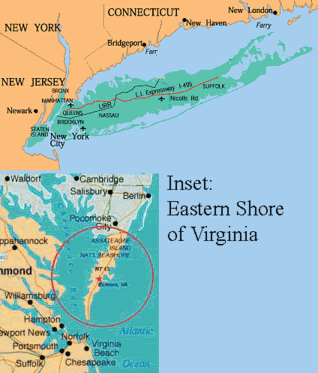
I've been reading Sphere for several months. I find it increasingly enjoyable. Actually, given the blog's focus, the environmental and developmental challenges of Long Island Sound and the surrounding region, "enjoyable" isn't always a fitting modifier, even if Tom Andersen's writing is generally excellent.
Most of the Long Island that my father knew as a child in the early 1940s is today gone, replaced by suburban sprawl. As human population increases, so too do the environmental pressures. Consider this laundry list of proposals and other local issues collected over the long weekend by Andersen. He describes proposed private condominium development on land that is presently owned by the state of Connecticut, boaters who are regularly pumping their heads (toilet holds) into the waters of the Sound, health officials closing some shellfish beds due to recent rainwater runoff, and threats of retribution levied (and some actual vandalism) on churches and mayors by anti-hunters intent on halting deer hunting. The only glimmer of hope in this otherwise ugly report is a University of Connecticut study that suggests communities in the region suffer for having too many parking lots, "thus increasing development costs, wasting land, deadening our urban centers, discouraging walking and riding, and adding to the runoff into our streams and rivers." The study itself points to discouraging truths, but perhaps the implicated towns will elect to reverse the trend, dubious though that outcome seems.
Having just returned from the Eastern Shore of Virginia, a peninsula on the brink of "discovery," I can't help but think that Long Island's environmental woes presage a similar future for my childhood home. Route 13 runs the length of "the Shore" and is situated more or less in the center of the narrow peninsula. Naturally, the highway is also the central artery for development. Along this stretch of road - two northbound lanes separated from two southbound lanes by a wide median - shopping centers, fast food joints, and gas stations have long been features. I was excited when the first Pizza Hut opened in Accomack County (in the early 1990s) because I was then naive enough to view the restaurant's arrival as a sign of progress. Fifteen years later, Wal-Mart(1) has proposed a store in the county, wealthy urbanites are prospecting property at outrageous rates, and Route 13 is a mess of billboards and chain stores. In short, "growth" has arrived.
The local reaction to these changes is understandable, but it makes for a troubling dynamic. Long time Shore residents discourage "come heres" - anyone who moves to the Shore from somewhere else - and resent them if they do settle in the area. On the one hand, I think this is as it should be, that locals should be resistant to development of any sort. Boycotting Wal-Mart while simultaneously embracing wealthy "come heres" will still result in a growing demand for amenities and commercial options that the Shore could do without. Transplants from the city want perks like central air, gourmet food stores and restaurants, "authentic" harbors and improved sailboat docks. What they find instead are wood stoves and chimneys, Food Lion and fast food, and working waterman standing on blood stained docks. This isn't exactly the idyllic retreat most urbanites have in mind. It's the rural south.
On the other hand, I sympathize with some of the urbanite wants. I'd love to see an organic food store open on the Shore, for example. Moreover, I accept that, given the world's burgeoning population, development of one kind or another is inevitable. With that in mind, why shouldn't locals fight back the Waltons while inviting the Rockefellers to dinner?
Of course, by courting outside money, the Shore runs the risk of establishing class ghettos and further corroding the already tenuous race relations. The Eastern Shore of Virginia is home to significant African American and Latin American minority populations. As more and more mansions spring up along the waterfront, I've also noticed more decrepit shacks in the fractured villages that line Route 13. Some of these residences are little more than 10' by 10' tarred boxes resting on cinderblocks. On the estates, "come heres" host cocktail parties and laugh about escaping the rat race. In the poverty stricken hovels a mile away, crack abuse is rampant and skinny kids play hoops with bushel baskets nailed to tired looking poles. Whether or not these children are oblivious to their worsening lot, the social dynamic is worrisome.
(1) If you are interested in reading more about WalMart's recent attempts to green their corporate practice, I suggest linking over to this Grist article. As Jeff writes over at Sustainablog, "Wal-Mart's business model makes genuine sustainability (or even a mere imitation of it) a pipe dream..."

1 comment:
This is a poignant discussion of the issues that are facing most communities in the developed world.
Can we start to think outside the box regarding community development? Can we rebuild our surrounding environment to be that idyllic spot with a booming local economy and still conserve the ecological services on which our civilization depends?
My gut tells me the answer is yes. But we must engage our communities to do so, and go through the brutal process of grassroots participation and the heated debate that is sure to follow. How do we energize our communities to move forward on these issues?
Post a Comment